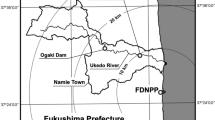Abstract
The reasons why rice 137Cs concentrations increase near the water inlet were investigated using rectangular experimental plots settled in paddy fields. The 137Cs concentrations in brown rice and rice straw were highest at 1 m from the inlet and decreased gradually with increasing distance, showing a negative correlation with soil exchangeable potassium content (Ex-K). The 137Cs concentration in brown rice was negatively and positively correlated with yield and sterility rate, respectively. These results suggest that soil Ex-K reduction and rice anomalies occurred near the water inlet and could contribute to the local elevation of 137Cs concentrations in rice.








Similar content being viewed by others
References
Chino M, Nakayama H, Nagai H et al (2011) Preliminary estimation of release amounts of 131I and 137Cs accidentally discharged from the Fukushima Daiichi nuclear power plant into the atmosphere. J Nucl Sci Technol 48:1129–1134
Nuclear Emergency Response Headquarters, Government of Japan (2011) Report of Japanese government to the IAEA ministerial conference on nuclear safety-The accident at TEPCO’s Fukushima Nuclear Power Stations. https://japan.kantei.go.jp/kan/topics/201106/iaea_houkokusho_e.html
Nihei N, Tanoi K, Nakanishi TM (2015) Inspections of radiocesium concentration levels in rice from Fukushima Prefecture after the Fukushima Dai-ichi nuclear power plant accident. Sci Rep 5:8653. https://doi.org/10.1038/srep08653
Fukushima Prefecture (2019) The official website for revitalization in Fukushima. https://www.pref.fukushima.lg.jp/sec/36035b/zenryouzenhukurokensa-kensakekka.html
Kato N, Kihou N, Fujimura S et al (2015) Potassium fertilizer and other materials as countermeasures to reduce radiocesium levels in rice: results of urgent experiments in 2011 responding to the Fukushima Daiichi Nuclear Power Plant accident. Soil Sci Plant Nutr 61:179–190
Nakao A, Ogasawara S, Sano O et al (2014) Radiocesium sorption in relation to clay mineralogy of paddy soils in Fukushima, Japan. Sci Total Environ 468:523–529
Monma T, Goto I, Hayashi T et al (2015) Agricultural and forestry reconstruction after the Great East Japan Earthquake. Springer Nature, Berlin
Evrard O, Laceby JP, Nakao A (2019) Effectiveness of landscape decontamination following the Fukushima nuclear accident: a review. Soil 5:333–350
Harada N, Nonaka M (2012) Soil radiocesium distribution in rice fields disturbed by farming process after the Fukushima Dai-ichi nuclear power plant accident. Sci Total Environ 438:242–247
Shin M, Kubota T, Hamada K et al (2015) Dynamic analysis of radioactive cesium in decontaminated paddy fields. J Water Environ Technol 13:383–394
Yoshikawa N, Obara H, Ogasa M et al (2014) 137Cs in irrigation water and its effect on paddy fields in Japan after the Fukushima nuclear accident. Sci Total Environ 481:252–259
Wakiyama Y, Konoplev A, Wada T et al (2017) Behavior of 137Cs in ponds in the vicinity of the Fukushima Dai-ichi nuclear power plant. J Environ Radioact 178:367–376
Yang B, Onda Y, Wakiyama Y et al (2016) Temporal changes of radiocesium in irrigated paddy fields and its accumulation in rice plants in Fukushima. Environ Pollut 208:562–570
Suzuki Y, Shoji R, Tsurumaki T (2019) Yearly changes in rice and soil radiocaesium concentrations in Minamisoma City, Fukushima Prefecture, Japan. Monitoring results from 2013 to 2016. Radioisotopes Online 68:1–12
Shin M, Kubota T, Manpuku Y et al (2019) Behavior of radiocesium in decontaminated paddy fields in Fukushima Prefecture, Japan. Paddy Water Environ 17:703–714
Yoshikawa N, Nakashima K, Suzuki Y et al (2020) Influence of irrigation water intake on local increase of radiocesium activity concentration in rice plants near a water inlet. J Environ Radioact 225:106441
Tsukada H, Hasegawa H, Hisamatsu S, Yamasaki S (2002) Transfer of 137Cs and stable Cs from paddy soil to polished rice in Aomori, Japan. J Environ Radioact 59:351–363
Endo S, Kajimoto T, Shizuma K (2013) Paddy-field contamination with 134Cs and 137Cs due to Fukushima Dai-ichi Nuclear Power Plant accident and soil-to-rice transfer coefficients. J Environ Radioact 116:59–64
Tagami K, Tsukada H, Uchida S, Howard BJ (2018) Changes in the soil to brown rice concentration ratio of radiocaesium before and after the Fukushima Daiichi Nuclear Power Plant accident in 2011. Environ Sci Technol 52:8339–8345
Yamamura K, Fujimura S, Ota T et al (2018) A statistical model for estimating the radiocesium transfer factor from soil to brown rice using the soil exchangeable potassium content. J Environ Radioact 195:114–125
Shimono H, Hasegawa T, Kuwagata T, Iwama K (2007) Modeling the effects of water temperature on rice growth and yield under a cool climate: II. Model application. Agron J 99:1338–1344
Acknowledgements
We especially thank the local farmers for managing the rice fields during the experiment. This research was financially supported in part by the Minamisoma City Government, the Mitsui & Co., Ltd. Environmental Fund, Japan, and the Grants-in-Aid for Scientific Research (Nos. 26511007 and 19H03072) from the Japan Society for the Promotion of Science.
Author information
Authors and Affiliations
Corresponding author
Additional information
Publisher's Note
Springer Nature remains neutral with regard to jurisdictional claims in published maps and institutional affiliations.
Rights and permissions
About this article
Cite this article
Suzuki, Y., Shoji, R., Tsurumaki, T. et al. Elevated rice 137Cs concentrations near the water inlet in paddy fields after the Fukushima nuclear accident. J Radioanal Nucl Chem 331, 3167–3173 (2022). https://doi.org/10.1007/s10967-022-08350-w
Received:
Accepted:
Published:
Issue Date:
DOI: https://doi.org/10.1007/s10967-022-08350-w




